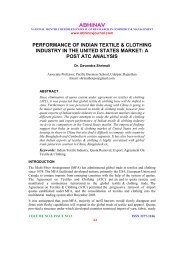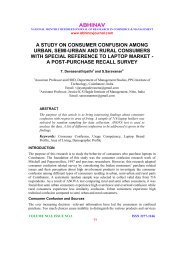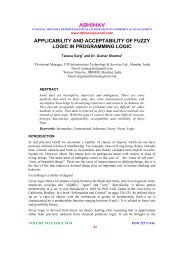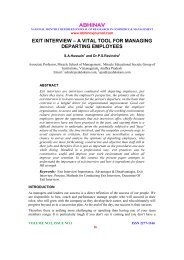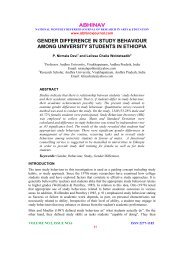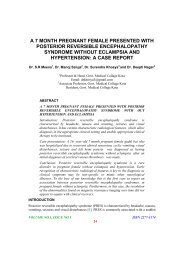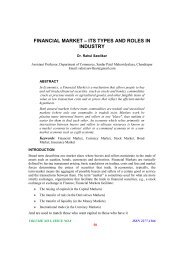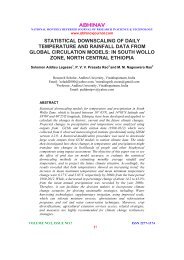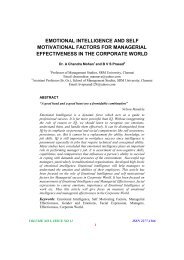A Study on âdifferentiator in Marketing of fresh fruits and Vegetables ...
A Study on âdifferentiator in Marketing of fresh fruits and Vegetables ...
A Study on âdifferentiator in Marketing of fresh fruits and Vegetables ...
Create successful ePaper yourself
Turn your PDF publications into a flip-book with our unique Google optimized e-Paper software.
A <str<strong>on</strong>g>Study</str<strong>on</strong>g> <strong>on</strong> “differentiator <strong>in</strong> Market<strong>in</strong>g <strong>of</strong> <strong>fresh</strong> <strong>fruits</strong><strong>and</strong> <strong>Vegetables</strong> from Supply Cha<strong>in</strong> ManagementPerspective”Mitul Deliya 1 , Ch<strong>and</strong>uji Thakor 2 <strong>and</strong> Bhavesh Parmar 31 Assistant Pr<strong>of</strong>essor, S. K. College <strong>of</strong> Bus<strong>in</strong>ess Management, PatanEmail: deliya_mitul@yahoo.<strong>in</strong>2 Assistant Pr<strong>of</strong>essor, VJKM Institute <strong>of</strong> Management & Computer Studies, Vadu,Email: chthakor@gmail.com3 Assistant Pr<strong>of</strong>essor, S.P. College <strong>of</strong> Eng<strong>in</strong>eer<strong>in</strong>g., VisnagarEmail: callbhavesh@gmail.comABSTRACTIn today’s competitive marketplace the pressure <strong>on</strong> organizati<strong>on</strong>s to f<strong>in</strong>dnew ways to shape <strong>and</strong> deliver value to customer grows ever str<strong>on</strong>ger.Gradually, <strong>in</strong> emerg<strong>in</strong>g ec<strong>on</strong>omies as well as developments markets, thepower <strong>of</strong> the seller has overtaken that <strong>of</strong> the customer. Supply cha<strong>in</strong>Management not <strong>on</strong>ly helps <strong>in</strong> cutt<strong>in</strong>g costs, but also adds to ma<strong>in</strong>ta<strong>in</strong> <strong>and</strong>improve The Quality <strong>of</strong> <strong>fruits</strong> <strong>and</strong> vegetables marketed. In market<strong>in</strong>g <strong>fruits</strong><strong>and</strong> vegetables, which are Perishable <strong>in</strong> nature, supply cha<strong>in</strong> plays a crucialrole. The very nature <strong>of</strong> l<strong>and</strong> hold<strong>in</strong>g by the farmers, Varied climatec<strong>on</strong>diti<strong>on</strong>s, producti<strong>on</strong> spread over wide geographical area, ma<strong>in</strong>ly <strong>in</strong>remote villages, diversified c<strong>on</strong>sumpti<strong>on</strong>s patterns <strong>and</strong> poor <strong>in</strong>frastructuremakes SCM for <strong>fruits</strong> <strong>and</strong> vegetables complicated. In India, SCM is at itsgrow<strong>in</strong>g stage <strong>in</strong> market<strong>in</strong>g <strong>of</strong> Fruits <strong>and</strong> <strong>Vegetables</strong>. Market<strong>in</strong>g <strong>of</strong> Fruits<strong>and</strong> <strong>Vegetables</strong> are challeng<strong>in</strong>g because <strong>of</strong> the perishability, seas<strong>on</strong>ality <strong>and</strong>bulk<strong>in</strong>ess <strong>and</strong> c<strong>on</strong>sumpti<strong>on</strong> habits <strong>of</strong> the Indian C<strong>on</strong>sumers. In additi<strong>on</strong> tothis, poor <strong>in</strong>frastructure, poor equity <strong>in</strong> SC <strong>and</strong> c<strong>on</strong>venti<strong>on</strong>al small scaleunorganized retailers, make state <strong>of</strong> the art supply cha<strong>in</strong> challeng<strong>in</strong>g <strong>in</strong> thepresent scenario. The Indian retail market is ma<strong>in</strong>ly dom<strong>in</strong>ated byunorganized retailers. The unorganized retailers are homogeneous group.Recent development <strong>in</strong> retail<strong>in</strong>g is the entry <strong>of</strong> large number <strong>of</strong> organizedretailers. Current supply cha<strong>in</strong> cater<strong>in</strong>g ma<strong>in</strong>ly to the unorganized retailersis riddled with number <strong>of</strong> drawbacks. As per this paper importantdrawbacks <strong>of</strong> the current supply cha<strong>in</strong> are number <strong>of</strong> <strong>in</strong>termediaries, highlevel <strong>of</strong> wastage, quality degradati<strong>on</strong>, poor <strong>in</strong>frastructural facilities <strong>and</strong>high cost. Government <strong>and</strong> private operators have to jo<strong>in</strong> h<strong>and</strong>s to improvethe physical <strong>in</strong>frastructure, <strong>in</strong>formati<strong>on</strong> shar<strong>in</strong>g <strong>and</strong> the service required forquality improvement <strong>of</strong> the supply cha<strong>in</strong>.Keywords: Fruits & vegetables, Supply cha<strong>in</strong> managementVOLUME NO.1, ISSUE NO.3 ISSN 2277-116640
ABHINAVNATIONAL MONTHLY REFEREED JOURNAL OF REASEARCH IN COMMERCE & MANAGEMENTwww.abh<strong>in</strong>avjournal.comINTRODUCTIONSCM is the coord<strong>in</strong>ati<strong>on</strong> <strong>of</strong> material flows, <strong>in</strong>formati<strong>on</strong> flows <strong>and</strong> f<strong>in</strong>ancial flows am<strong>on</strong>g allthe participat<strong>in</strong>g organizati<strong>on</strong>s so as to ensure that the right product <strong>in</strong> the right place, at theright price, at the right time, <strong>and</strong> <strong>in</strong> the right c<strong>on</strong>diti<strong>on</strong>. Supply Cha<strong>in</strong> Management plays animportant role <strong>in</strong> market<strong>in</strong>g <strong>of</strong> goods <strong>and</strong> services. “It is the supply that compete, <strong>and</strong> not<strong>in</strong>dividual bus<strong>in</strong>esses” – is an accepted say<strong>in</strong>g. Every bus<strong>in</strong>ess plans to cut costs, which d<strong>on</strong>ot adds to ma<strong>in</strong>ta<strong>in</strong> <strong>and</strong> improve the quality <strong>of</strong> goods <strong>and</strong> services delivered. In thisdirecti<strong>on</strong>, supply cha<strong>in</strong> has played major role across the world <strong>in</strong> varied sectors.SCM not<strong>on</strong>ly helps to cut costs, but also adds to ma<strong>in</strong>ta<strong>in</strong> <strong>and</strong> improve the quality <strong>of</strong> goods <strong>and</strong>services delivered. In this directi<strong>on</strong>, Supply cha<strong>in</strong> has played a major role across the world <strong>in</strong>varied sectors. In market<strong>in</strong>g <strong>fruits</strong> <strong>and</strong> vegetables, which are perishable <strong>in</strong> nature, SC plays acrucial role. The very nature <strong>of</strong> l<strong>and</strong> hold<strong>in</strong>g by the farmers, varied climate c<strong>on</strong>diti<strong>on</strong>s,producti<strong>on</strong> spread over worldwide geographical area, ma<strong>in</strong>ly <strong>in</strong> remote villages, diversifiedc<strong>on</strong>sumpti<strong>on</strong> patterns <strong>and</strong> poor SC <strong>in</strong>frastructure make SCM for <strong>fruits</strong> <strong>and</strong> vegetables morecomplicated. Efficient SCM <strong>in</strong> market<strong>in</strong>g, not <strong>on</strong>ly <strong>in</strong>creases the pr<strong>of</strong>itability <strong>and</strong> efficiency<strong>of</strong> retailers, but also adds value to different stakeholders like farmers, c<strong>on</strong>solidators <strong>and</strong>c<strong>on</strong>sumers.Fruit <strong>and</strong> <strong>Vegetables</strong> - Current ScenarioIndia is the fruit <strong>and</strong> vegetable basket <strong>of</strong> the world. India be<strong>in</strong>g a home <strong>of</strong> wide variety <strong>of</strong><strong>fruits</strong> <strong>and</strong> vegetables holds a unique positi<strong>on</strong> <strong>in</strong> producti<strong>on</strong> figures am<strong>on</strong>g other countries.Over 90% <strong>of</strong> India's exports <strong>in</strong> <strong>fresh</strong> products goes to west Asia <strong>and</strong> East European markets.However, it needs to augment its food <strong>and</strong> process<strong>in</strong>g <strong>in</strong>dustry at a mega scale, accord<strong>in</strong>g toan agriculture c<strong>on</strong>sultant. The covered area under the <strong>fresh</strong> <strong>fruits</strong> <strong>in</strong> India was 5510000 Hawith the producti<strong>on</strong> <strong>of</strong> 58740000 MT <strong>in</strong> 2005-06. The major <strong>fruits</strong> grown <strong>in</strong> India areMangos, Grapes, Apple, Apricots, Orange, Banana Fresh, Avocados, Guava, Lichi, Papaya,Sapota <strong>and</strong> Water Mel<strong>on</strong>s. This is due to its potential <strong>in</strong> different agro climatic z<strong>on</strong>es India'sExport <strong>of</strong> Fresh Fruits has <strong>in</strong>creased from Rs. 225.67 Crores (USD Milli<strong>on</strong> 50.98) <strong>in</strong> 2005-06 to 256.43 Crores (USD Milli<strong>on</strong> 56.88) <strong>in</strong> 2006-07. The Major countries which importFresh <strong>fruits</strong> from India are U.K, Netherl<strong>and</strong>s, U.A.E, Russia, Bahra<strong>in</strong>, Qatar, Kuwait, SaudiArabia, Bangladesh, Nepal.Total vegetable producti<strong>on</strong> <strong>in</strong> India before <strong>in</strong>dependence was 15 milli<strong>on</strong> mt <strong>and</strong> s<strong>in</strong>ceIndependence for decades the growth rate was stabilized around 0.5%. The impetus <strong>on</strong>vegetable research <strong>and</strong> policy <strong>in</strong>terventi<strong>on</strong> to promote vegetable crops witnessed a suddenspurt <strong>in</strong> growth rate <strong>of</strong> 2.5%, a hike <strong>of</strong> five times dur<strong>in</strong>g the last decade. Major vegetablesgrown <strong>in</strong> India are Potato, Oni<strong>on</strong>, Tomato, Cauliflower, Cabbage, Bean, Egg Plants,Cucumber <strong>and</strong> Gark<strong>in</strong>, Frozen Peas, Garlic <strong>and</strong> okra. India's exports <strong>of</strong> Fresh Fruit <strong>and</strong>Vegetable has <strong>in</strong>creased from Rs. 1658.72 Crores (USD Milli<strong>on</strong> 374.68) <strong>in</strong> 2005-06 to Rs.2411.66 Crores (USD Milli<strong>on</strong> 534.97) <strong>in</strong> 2006-07.India ranks fifth <strong>in</strong> the world <strong>in</strong> cropped area under cultivati<strong>on</strong> <strong>and</strong> producti<strong>on</strong> <strong>of</strong> potatoes.India produces 41% <strong>of</strong> world's mangoes, 23%bananas, 24% cashew nuts, 36 % green peas<strong>and</strong> 10% <strong>on</strong>i<strong>on</strong> The total export value <strong>of</strong> the ma<strong>in</strong> export<strong>in</strong>g fruit crop from India is mango.Exports <strong>of</strong> mangoes, grapes, mushrooms have started go<strong>in</strong>g to the United K<strong>in</strong>gdom, MiddleEast, S<strong>in</strong>gapore <strong>and</strong> H<strong>on</strong>g K<strong>on</strong>g. <strong>and</strong> am<strong>on</strong>g vegetable, <strong>on</strong>i<strong>on</strong> occupies first positi<strong>on</strong>VOLUME NO.1, ISSUE NO.3 ISSN 2277-116641
ABHINAVNATIONAL MONTHLY REFEREED JOURNAL OF REASEARCH IN COMMERCE & MANAGEMENTwww.abh<strong>in</strong>avjournal.comPotatoes <strong>and</strong> green vegetables like okra, bitter gourd, green chillies have good exportpotential.India is 2nd largest <strong>on</strong>i<strong>on</strong> grow<strong>in</strong>g country <strong>in</strong> the world. Indian <strong>on</strong>i<strong>on</strong>s are famous worldwidefor their pungency. The Gulf countries are the ma<strong>in</strong> importers <strong>of</strong> the <strong>on</strong>i<strong>on</strong> bulb, <strong>and</strong>neighbor<strong>in</strong>g Pakistan <strong>and</strong> Ch<strong>in</strong>a are India's ma<strong>in</strong> competitors <strong>in</strong> the global market. India'sExport <strong>of</strong> Oni<strong>on</strong> has <strong>in</strong>creased from Rs. 708.15 Crores (USD Milli<strong>on</strong> 159.96) <strong>in</strong> 2005-06 toRs. 1163.30 Crores (USD Milli<strong>on</strong> 258.05) <strong>in</strong> 2006-07. Bangladesh, Malaysia, Sri Lanka,U.A.E, Pakistan <strong>and</strong> Nepal are the Major market <strong>of</strong> Indian Oni<strong>on</strong>.Mango, called the k<strong>in</strong>g <strong>of</strong> <strong>fruits</strong> <strong>in</strong> India, accounts for 40 percent <strong>of</strong> the nati<strong>on</strong>al fruitproducti<strong>on</strong> <strong>of</strong> 22.168 milli<strong>on</strong> t<strong>on</strong>nes a year. It occupies 42 percent <strong>of</strong> the country's 24.87milli<strong>on</strong> hectares l<strong>and</strong> under fruit cultivati<strong>on</strong>. India exported 79,060.88 MT <strong>of</strong> <strong>fresh</strong> mangoeswith the value <strong>of</strong> Rs. 141.93 Crores (USD Milli<strong>on</strong> 31.48) <strong>in</strong> 2006-07. India is estimated toaccount for about 60 percent (9.5 milli<strong>on</strong> t<strong>on</strong>nes) <strong>of</strong> the world's mango producti<strong>on</strong> <strong>of</strong> 15.7milli<strong>on</strong> t<strong>on</strong>es. The major producti<strong>on</strong> areas <strong>in</strong> the country are <strong>in</strong> the States <strong>of</strong> Andhra Pradesh,Uttar Pradesh, Karnataka, Bihar, Gujarat <strong>and</strong> Maharashtra.Fruits <strong>and</strong> <strong>Vegetables</strong> – Producti<strong>on</strong> <strong>and</strong> C<strong>on</strong>sumpti<strong>on</strong> ScenarioF&V play a vital role <strong>in</strong> human diet as <strong>fresh</strong> foods sources <strong>of</strong> calories, vitam<strong>in</strong>s, dietary fiber<strong>and</strong> special nutrients. India‟ s vast geographical area coupled with varied climate c<strong>on</strong>diti<strong>on</strong>sfacilitates to grow a variety <strong>of</strong> F&V. if c<strong>on</strong>cerned effort is made by all the stakeholders, thereis every possibilities that India emerges as the lead<strong>in</strong>g horticultural crops produc<strong>in</strong>g,process<strong>in</strong>g, export<strong>in</strong>g <strong>and</strong> c<strong>on</strong>sum<strong>in</strong>g country <strong>in</strong> the world. India is an agriculture basedcountry. Hundreds <strong>of</strong> <strong>fruits</strong> <strong>and</strong> vegetables types are grown <strong>in</strong> all parts <strong>of</strong> India. Fresh fruit<strong>and</strong> vegetable reach small scale <strong>fruits</strong> vegetables suppliers, they are then sent to localmarkets as well as <strong>fruits</strong> <strong>and</strong> vegetables exporters. Last decades have seen the number <strong>of</strong>Indian fruit vegetables suppliers <strong>and</strong> <strong>fruits</strong> vegetables exporters ris<strong>in</strong>g to an all time high.Especially there has been a steep rise <strong>in</strong> the number <strong>of</strong> vegetable exporters.The total producti<strong>on</strong> <strong>of</strong> <strong>fruits</strong> <strong>and</strong> vegetables <strong>in</strong> the world is around 370 MT. India ranks first<strong>in</strong> the world with an annual output <strong>of</strong> 32 MT. While there are almost 180 families <strong>of</strong> <strong>fruits</strong>that are grown all over the world, citrus <strong>fruits</strong> c<strong>on</strong>stitute around 20% <strong>of</strong> world‟s total fruitproducti<strong>on</strong>. Major Indian <strong>fruits</strong> c<strong>on</strong>sist <strong>of</strong> mango, banana, citrus <strong>fruits</strong>, apple, guava, papaya,p<strong>in</strong>eapple <strong>and</strong> grapes. The <strong>fruits</strong> are processed <strong>in</strong>to various products such as fruit juices &c<strong>on</strong>centrates, canned fruit, dehydrated fruit, jams & jellies etc.India with its current producti<strong>on</strong> <strong>of</strong> around 32 milli<strong>on</strong> MT <strong>of</strong> fruit, accounts for about 8% <strong>of</strong>the world‟s fruit producti<strong>on</strong>. The diverse agro-climatic z<strong>on</strong>es the country make it possible togrow almost all varieties <strong>of</strong> <strong>fresh</strong> <strong>fruits</strong> <strong>and</strong> vegetables <strong>in</strong> India. The fruit producti<strong>on</strong> <strong>in</strong> Indiahas recorded a growth rate <strong>of</strong> 3.9%, whereas the fruit process<strong>in</strong>g sector has grown at about20% per annum. However, the growth rates have been extensively higher for frozen <strong>fruits</strong> &vegetables (121%) <strong>and</strong> dehydrated <strong>fruits</strong> & vegetables (24%). There exist over 4000 fruitprocess<strong>in</strong>g units <strong>in</strong> India with an aggregate capacity <strong>of</strong> more than 12 lakh MT (less than 4%<strong>of</strong> total <strong>fruits</strong> produced). It is estimated that around 20% <strong>of</strong> the producti<strong>on</strong> <strong>of</strong> processed <strong>fruits</strong>is meant for exports, the rest caters to the defense, <strong>in</strong>stituti<strong>on</strong>al sectors <strong>and</strong> householdc<strong>on</strong>sumpti<strong>on</strong>, Mango <strong>and</strong> mango-based products c<strong>on</strong>stitute 50% <strong>of</strong> exports. India is thesec<strong>on</strong>d largest producer <strong>of</strong> vegetables <strong>in</strong> the world (ranks next to Ch<strong>in</strong>a) <strong>and</strong> accounts forVOLUME NO.1, ISSUE NO.3 ISSN 2277-116642
ABHINAVNATIONAL MONTHLY REFEREED JOURNAL OF REASEARCH IN COMMERCE & MANAGEMENTwww.abh<strong>in</strong>avjournal.comabout 15% <strong>of</strong> the world‟s producti<strong>on</strong> <strong>of</strong> vegetables. The current producti<strong>on</strong> level is over 71milli<strong>on</strong> MT <strong>and</strong> the total area under vegetable cultivati<strong>on</strong> is around 6.2 milli<strong>on</strong> hectareswhich is about 3% <strong>of</strong> the total area under cultivati<strong>on</strong> <strong>in</strong> the country. In case <strong>of</strong> vegetables,potato, tomato, <strong>on</strong>i<strong>on</strong>, cabbage <strong>and</strong> cauliflower account for around 60% <strong>of</strong> the total vegetableproducti<strong>on</strong> <strong>in</strong> the country. <strong>Vegetables</strong> are typically grown <strong>in</strong> India <strong>in</strong> field c<strong>on</strong>diti<strong>on</strong>s, thec<strong>on</strong>cept is opposed to the cultivati<strong>on</strong> <strong>of</strong> vegetables <strong>in</strong> green houses as practiced <strong>in</strong> developedcountries for high yields. The fruit <strong>and</strong> vegetable process<strong>in</strong>g <strong>in</strong>dustry <strong>in</strong> India is highlydecentralized. India produces 129 milli<strong>on</strong> t<strong>on</strong>s <strong>of</strong> vegetables <strong>and</strong> the total area undervegetable cultivati<strong>on</strong> is around 7.9 milli<strong>on</strong> ha. Am<strong>on</strong>g vegetables, potato, tomato, <strong>on</strong>i<strong>on</strong>,cabbage <strong>and</strong> cauliflower account for around 60% <strong>of</strong> the total vegetable producti<strong>on</strong> <strong>in</strong> terms<strong>of</strong> Quantity. India ranks first <strong>in</strong> fruit producti<strong>on</strong> <strong>in</strong> the world with an annual output <strong>of</strong> 68milli<strong>on</strong> t<strong>on</strong>s. There are almost 180 families <strong>of</strong> <strong>fruits</strong> that are grown all over the world. S<strong>in</strong>celiberalisati<strong>on</strong> <strong>and</strong> withdrawal <strong>of</strong> excise duty <strong>on</strong> fruit <strong>and</strong> vegetable products there has beensignificant rise <strong>in</strong> the growth rate <strong>of</strong> the <strong>in</strong>dustry.The per capita c<strong>on</strong>sumpti<strong>on</strong> <strong>of</strong> both F&V <strong>in</strong> India is far below the world HealthOrganizati<strong>on</strong>(WHO) recommendati<strong>on</strong>s. For example, the current producti<strong>on</strong> <strong>of</strong> 129 milli<strong>on</strong>t<strong>on</strong>s <strong>of</strong> vegetables is sufficient to provide <strong>on</strong>ly a per capita availability <strong>of</strong> 120 gm <strong>of</strong>vegetables a day (as per 2001 populati<strong>on</strong> census) as aga<strong>in</strong>st the balanced diet requirement <strong>of</strong>400 gm as per WHO recommendati<strong>on</strong>s. Large number <strong>of</strong> farmers depend<strong>in</strong>g <strong>on</strong> m<strong>on</strong>so<strong>on</strong>,small l<strong>and</strong> hold<strong>in</strong>gs, low yield, negligible <strong>in</strong>vestments <strong>and</strong> poor ma<strong>in</strong>tenance <strong>of</strong> cold storage,markets, all weather roads <strong>and</strong> transportati<strong>on</strong> facilities are the major hurdles for the growth<strong>of</strong> the horticultural sector <strong>in</strong> India. In India just about 2% <strong>of</strong> F&V grown goes for process<strong>in</strong>g,while over 25% is spoiled due to improper h<strong>and</strong>l<strong>in</strong>g <strong>and</strong> storage, <strong>and</strong> the rest is c<strong>on</strong>sumed <strong>in</strong><strong>fresh</strong> form. Keep<strong>in</strong>g <strong>in</strong> m<strong>in</strong>d the importance <strong>of</strong> horticultural products <strong>and</strong> the challengesfaced by this sector. The Nati<strong>on</strong>al Horticultural Missi<strong>on</strong> was Launched <strong>in</strong> 2005-06 by theGovernment <strong>of</strong> India with a m<strong>and</strong>ate to promote <strong>in</strong>tegrated development <strong>in</strong> horticultural, tohelp <strong>in</strong> coord<strong>in</strong>at<strong>in</strong>g, stimulat<strong>in</strong>g <strong>and</strong> susta<strong>in</strong><strong>in</strong>g the producti<strong>on</strong> <strong>and</strong> process<strong>in</strong>g <strong>of</strong> F&V, <strong>and</strong>to establish a sound <strong>in</strong>frastructure with a focus <strong>on</strong> post-harvest management to reducelosses.Fruit <strong>and</strong> Vegetable - Producti<strong>on</strong> ScenarioProducti<strong>on</strong> <strong>of</strong> Major Fruits <strong>and</strong> <strong>Vegetables</strong>: India's Positi<strong>on</strong> <strong>in</strong> the World, 1996Sr. No. Fruits/ <strong>Vegetables</strong>Producti<strong>on</strong> (000 MT) India's India'sIndia World Share RankFruits1 Mango 10000 19215 52.0 12 Banana 15073 55787 27.0 13 Apple 1200 53672 2.2 104 P<strong>in</strong>eapple 820 11757 7.0 55 Papaya 490 5867 8.4 46 Orange 2000 59558 3.4 67 Grapes 1083 5004 21.6 88 Lime 1700 9104 18.7 1VOLUME NO.1, ISSUE NO.3 ISSN 2277-116643
ABHINAVNATIONAL MONTHLY REFEREED JOURNAL OF REASEARCH IN COMMERCE & MANAGEMENTwww.abh<strong>in</strong>avjournal.comProducti<strong>on</strong> <strong>of</strong> Major Fruits <strong>and</strong> <strong>Vegetables</strong>: India's Positi<strong>on</strong> <strong>in</strong> the World, 1996(C<strong>on</strong>td…)Sr. No. Fruits/ <strong>Vegetables</strong> Producti<strong>on</strong> (000 MT) India's India'sIndia World Share Rank<strong>Vegetables</strong>1 Tomato 4800 84873 5.7 62 Oni<strong>on</strong> 4058 36544 11.1 23 Br<strong>in</strong>jal 8026 11981 67.0 14 Potato 17942 294834 6.1 65 Green Peas 270 5214 5.2 56 Cabbage 3300 46656 7.1 37 Cauliflower 4800 12725 37.7 18 Garlic 350 10401 3.4 3Source: Horticultural Statistics, 1999, Department <strong>of</strong> Horticulture http://www.Postharvest<strong>in</strong>dia.com/<strong>in</strong>dhrvst/<strong>fruits</strong>.htmMETHODOLOGYThe study covers the market<strong>in</strong>g <strong>of</strong> Fruits <strong>and</strong> <strong>Vegetables</strong> from Supply cha<strong>in</strong> perspective <strong>and</strong>elaborate this study by sec<strong>on</strong>dary data has been collected <strong>and</strong> analyzed. The present study isbased <strong>on</strong> <strong>in</strong>formati<strong>on</strong> collected from: the market <strong>of</strong>ficials <strong>of</strong> the selected <strong>fruits</strong> <strong>and</strong>vegetable markets, commissi<strong>on</strong> agents/wholesalers, retailers <strong>and</strong> farmers <strong>in</strong> <strong>and</strong> aroundthe selected Areas. The market <strong>of</strong>ficials were c<strong>on</strong>sulted for gather<strong>in</strong>g the <strong>in</strong>formati<strong>on</strong> <strong>on</strong>the overall activities <strong>of</strong> these markets, market<strong>in</strong>g <strong>in</strong>frastructure <strong>and</strong> other related<strong>in</strong>formati<strong>on</strong>.The sec<strong>on</strong>dary <strong>in</strong>formati<strong>on</strong> was collected from the report <strong>of</strong> Nati<strong>on</strong>al HorticulturalDepartment <strong>of</strong> India, St<strong>and</strong>ard books, Internati<strong>on</strong>al Journals, articles <strong>and</strong> websites were alsoreferred to.OBJECTIVES OF THE STUDYThe study has been made with the follow<strong>in</strong>g set <strong>of</strong> objectives:To know the significant role <strong>of</strong> Supply Cha<strong>in</strong> for Market<strong>in</strong>g <strong>of</strong> Fruit <strong>and</strong> <strong>Vegetables</strong>To know the role played by the various <strong>in</strong>termediaries <strong>in</strong> Supply Cha<strong>in</strong>.To know the market segments <strong>of</strong> fruit <strong>and</strong> Vegetable.Identify the New possibilities <strong>in</strong> the Supply Cha<strong>in</strong> Management for Fruit <strong>and</strong><strong>Vegetables</strong>.Identify <strong>and</strong> develop the Organized Retail<strong>in</strong>g <strong>of</strong> Fruit <strong>and</strong> Vegetable.Introducti<strong>on</strong> to the selected MarketsBefore the establishment <strong>of</strong> regulated markets <strong>in</strong> Ahmedabad, wholesale trade <strong>in</strong> <strong>fruits</strong> <strong>and</strong>vegetables was largely c<strong>on</strong>trolled by a few traders. Unfair <strong>and</strong> exploitative practices werecomm<strong>on</strong> at that time <strong>and</strong> the market efficiency was very low. S<strong>in</strong>ce the establishment <strong>of</strong>VOLUME NO.1, ISSUE NO.3 ISSN 2277-116644
ABHINAVNATIONAL MONTHLY REFEREED JOURNAL OF REASEARCH IN COMMERCE & MANAGEMENTwww.abh<strong>in</strong>avjournal.comMarket Committee <strong>in</strong> 1948 under the Market Regulati<strong>on</strong> Act, a govern<strong>in</strong>g body c<strong>on</strong>sist<strong>in</strong>g <strong>of</strong>representatives <strong>of</strong> licensed commissi<strong>on</strong> agents, farmers, traders, co- operatives <strong>and</strong> thegovernment have gradually taken c<strong>on</strong>trol <strong>of</strong> supervis<strong>in</strong>g the <strong>fruits</strong> <strong>and</strong> vegetables wholesaletrade. This Committee is known as the Agricultural Produce Market<strong>in</strong>g Committee (APMC)<strong>and</strong> it c<strong>on</strong>trols <strong>and</strong> adm<strong>in</strong>isters the regulated markets. Members <strong>of</strong> this Committee <strong>in</strong>cludefarmers, traders, cooperative market<strong>in</strong>g societies, cooperative/commercial banks, <strong>of</strong>ficials <strong>of</strong>local bodies <strong>and</strong> the government. As <strong>of</strong> today there are three wholesale market yards <strong>in</strong>Ahmedabad City for <strong>fruits</strong> <strong>and</strong> vegetables adm<strong>in</strong>istered by the APMC.Year <strong>of</strong> Establishment, Size <strong>of</strong> Market Yard <strong>and</strong> Licensed Traders <strong>in</strong> the selected MarketsMarketNumber <strong>of</strong> licensed tradersYear <strong>of</strong> Plot sizeOfficeEstablishment (Sq.Yds)Commissi<strong>on</strong> Co-op.Others StaffAgent Soc.AhmedabadSardar Patel Market 1980 16000 159 3 33C J Patel Market 1996 50000 115 2 3 10Naroda Fruits Market 1998 22577 120 9Source: APMC, AhmedabadRate <strong>of</strong> Commissi<strong>on</strong>/Market Charges at the APMC, AhmedabadParticulars Rate (Rs.) UnitRecoverablefromCommissi<strong>on</strong> Charge 6.00 Rs. 100 PurchaserMarket Fee 0.50 Rs. 100 PurchaserWeighman Charges (Unload<strong>in</strong>g & Tolai)Green & Leafy Vegetable 1.00 Upto 30 Kg. Purchaser2.00 31 Kg to 60 Kg Purchaser2.50 61 kg & above PurchaserTomato / Fruits 1.00 One box PurchaserPotato / Oni<strong>on</strong>s 1.75 Small bag Purchaser2.50 Big bag PurchaserFrom B.G. Stati<strong>on</strong> to Market Yard 1.00 Big bag Purchaser0.80 Small bag PurchaserFrom M.G. Stati<strong>on</strong> to Market Yard 1.20 Big bag Purchaser1.00 Small bag PurchaserMarfatGoods Tra<strong>in</strong> 0.05 One bag PurchaserPassenger Tra<strong>in</strong> 0.10 One bag PurchaserRecord<strong>in</strong>g Charges 0.01 One bag PurchaserSource: APMC, AhmedabadVOLUME NO.1, ISSUE NO.3 ISSN 2277-116645
ABHINAVNATIONAL MONTHLY REFEREED JOURNAL OF REASEARCH IN COMMERCE & MANAGEMENTwww.abh<strong>in</strong>avjournal.comArrivals & TurnoverApril to March2008-09April to March2009-10April to March2010-11Arrivals <strong>of</strong> <strong>Vegetables</strong> <strong>in</strong> Qu<strong>in</strong>tals 71,57,154 76,85,120 75,36,246Total Turnover <strong>of</strong> <strong>Vegetables</strong> Rs. 6,01,41,81,725 7,91,13,31,081 9,29,30,71,765Arrivals <strong>of</strong> Fruits <strong>in</strong> Qu<strong>in</strong>tals 20,86,220 17,37,824 18,55,933Total Turn over <strong>of</strong> Fruits Rs. 2,37,58,02,591 2,97,31,97,359 2,89,87,74,388Total arrivals <strong>of</strong> Fruits, <strong>Vegetables</strong>& Gra<strong>in</strong>s <strong>in</strong> Qu<strong>in</strong>tals95,23,778 98,25,117 99,27,707Source: APMC, AhmedabadSub YardsSardar Patel MarketRajnagar-Bhagubhai V<strong>and</strong>a MarketMunicipal Manekchawk MarketNaroda Fruit MarketP<strong>and</strong>it D<strong>in</strong>dayal Dascroi Gra<strong>in</strong> MarketSource: APMC, AhmedabadArea16,211 Sq.Yds.7,519 Sq.Yds.4,237 Sq.Yds.22,577 Sq.Yds.1,07,000 Sq.YdsRate Published On: 13 September, 2011: [RATE PER QUINTAL]Name Maximum price [rs.] M<strong>in</strong>imum price [rs.]Potato local 650.00 400.00Potato deesa 850.00 500.00Oni<strong>on</strong> saurastra 1,000.00 500.00Sweet potato 1,300.00 1,200.00Br<strong>in</strong>jal 2,000.00 1,000.00Cabbage 1,000.00 700.00Cauli flower 1,500.00 800.00Beans broad 4,500.00 2,500.00Tomato green 500.00 400.00Tomato red (ripe) 900.00 500.00Oni<strong>on</strong> green 1,500.00 700.00Garlic dry 4,500.00 2,000.00VOLUME NO.1, ISSUE NO.3 ISSN 2277-116646
ABHINAVNATIONAL MONTHLY REFEREED JOURNAL OF REASEARCH IN COMMERCE & MANAGEMENTwww.abh<strong>in</strong>avjournal.comRate Published On: 13 September, 2011: [RATE PER QUINTAL](C<strong>on</strong>td…)Name Maximum price [rs.] M<strong>in</strong>imum price [rs.]Lady's f<strong>in</strong>ger 2,500.00 1,500.00Cucumber 1,200.00 800.00T<strong>in</strong>da 3,700.00 3,500.00Chilies green 1,100.00 700.00Capsicum 3,000.00 1,000.00Lem<strong>on</strong> 1,000.00 500.00G<strong>in</strong>ger 1,800.00 1,200.00Green banana 600.00 400.00Source: APMC, AhmedabadFruit <strong>and</strong> vegetable - Market<strong>in</strong>g ScenarioMarket<strong>in</strong>g <strong>of</strong> agricultural produces is different <strong>and</strong> more challeng<strong>in</strong>g than many <strong>of</strong> the<strong>in</strong>dustrial products. The market<strong>in</strong>g <strong>of</strong> Horticultural products that too <strong>of</strong> the F&V, is morechalleng<strong>in</strong>g because <strong>of</strong> the perishability, seas<strong>on</strong>ality <strong>and</strong> bulk<strong>in</strong>ess <strong>and</strong> c<strong>on</strong>sumpti<strong>on</strong> habits<strong>of</strong> the Indian C<strong>on</strong>sumers. Indian c<strong>on</strong>sumer dem<strong>and</strong>s <strong>fresh</strong> F&V. The ma<strong>in</strong> stakeholders <strong>in</strong>market<strong>in</strong>g cha<strong>in</strong> from growers to c<strong>on</strong>sumers are wholesalers, retailers <strong>and</strong> other middlemen.It is necessary to focus <strong>on</strong> market<strong>in</strong>g <strong>of</strong> F&V from the po<strong>in</strong>t <strong>of</strong> all the stakeholders fromgrowers to c<strong>on</strong>sumers. Market<strong>in</strong>g efficiency not <strong>on</strong>ly helps <strong>in</strong> <strong>in</strong>creased producti<strong>on</strong> <strong>and</strong> percapita c<strong>on</strong>sumpti<strong>on</strong>, but also c<strong>on</strong>tributes to ec<strong>on</strong>omic development <strong>of</strong> the country. F&Vmarket<strong>in</strong>g deals with all the activities, agencies, <strong>and</strong> policies <strong>in</strong>volved <strong>in</strong> the procurement <strong>of</strong>F&V <strong>in</strong>puts by the farmers <strong>and</strong> the movement <strong>of</strong> F&V from the farm to c<strong>on</strong>sumers. TheF&V market<strong>in</strong>g system is a l<strong>in</strong>k between the farm <strong>and</strong> c<strong>on</strong>sumers. It <strong>in</strong>volves all thefuncti<strong>on</strong>al aspects <strong>of</strong> market namely pre <strong>and</strong> post harvest operati<strong>on</strong>s, assembl<strong>in</strong>g, sort<strong>in</strong>g,grad<strong>in</strong>g, storage, transportati<strong>on</strong> <strong>and</strong> distributi<strong>on</strong>. There has been c<strong>on</strong>cern <strong>in</strong> recent yearsregard<strong>in</strong>g the efficiency <strong>of</strong> market<strong>in</strong>g <strong>of</strong> F&V. High <strong>and</strong> fluctuat<strong>in</strong>g prices <strong>and</strong> availability <strong>of</strong>quality produce are matters <strong>of</strong> c<strong>on</strong>cern from the po<strong>in</strong>t <strong>of</strong> c<strong>on</strong>sumers. Only a small share <strong>of</strong>c<strong>on</strong>sumer rupee reach<strong>in</strong>g the farmers is another major c<strong>on</strong>cern <strong>in</strong> market<strong>in</strong>g <strong>of</strong> F&V. Indiahas a huge opportunity to become a lead<strong>in</strong>g global food supplier, if <strong>on</strong>ly it has the rightmarket<strong>in</strong>g strategies <strong>and</strong> <strong>of</strong> course, agile, adaptive <strong>and</strong> efficient Supply Cha<strong>in</strong>. India has avast diversity <strong>in</strong> producti<strong>on</strong>, with several religious <strong>and</strong> sub-cultural groups, different foodhabits <strong>and</strong> cultural. As a result, it has huge <strong>and</strong> vibrant domestic market, too.While ch<strong>in</strong>a is currently the largest F&V producers with 34% <strong>of</strong> global producti<strong>on</strong>. India‟sshare <strong>in</strong> the global exports <strong>of</strong> vegetables is <strong>on</strong>ly 1.7% <strong>and</strong> <strong>in</strong> <strong>fruits</strong> a <strong>in</strong>adequate 0.5%.Ch<strong>in</strong>a, Thail<strong>and</strong>, Chile <strong>and</strong> Turkey account for 58% <strong>of</strong> develop<strong>in</strong>g countries exports <strong>of</strong>VOLUME NO.1, ISSUE NO.3 ISSN 2277-116647
ABHINAVNATIONAL MONTHLY REFEREED JOURNAL OF REASEARCH IN COMMERCE & MANAGEMENTwww.abh<strong>in</strong>avjournal.comprocessed F&V, though the share <strong>of</strong> develop<strong>in</strong>g countries as a whole <strong>in</strong> the export <strong>of</strong>processed products is 36%.Entry <strong>of</strong> Organized RetailersRetail is <strong>on</strong>e <strong>of</strong> the fastest grow<strong>in</strong>g sectors <strong>in</strong> the world. “The retail bus<strong>in</strong>ess <strong>in</strong> India isestimated to grow at 13% per annum from US$ 322 billi<strong>on</strong> <strong>in</strong> 2006-07 to US$ 590 billi<strong>on</strong> <strong>in</strong>2011-12. While the unorganized sector is expected to grow at about 10% per annum, theorganized retail is estimated to grow at 45-50% per annum dur<strong>in</strong>g the same period” (ICRIER,2008). However, organised retail c<strong>on</strong>stitutes <strong>on</strong>ly around 4% <strong>of</strong> the total retail sales <strong>in</strong> India,compared to 75-80% <strong>in</strong> developed countries such as USA, Japan <strong>and</strong> UK.The Indian retail market is ma<strong>in</strong>ly dom<strong>in</strong>ated by unorganized retailers. The unorganizedretailers are not a homogeneous group. Generally, these retailers operate <strong>on</strong> a small scale.Recent developments <strong>in</strong> retail<strong>in</strong>g is the entry <strong>of</strong> large number <strong>of</strong> organized retailers. Thereare arguments both for <strong>and</strong> aga<strong>in</strong>st allow<strong>in</strong>g foreign Direct Investment <strong>in</strong> retail<strong>in</strong>g <strong>in</strong> India.In this scenario, the country is go<strong>in</strong>g to witness rapid developments <strong>in</strong> retail<strong>in</strong>g. Indianmiddle <strong>and</strong> upper middle class populati<strong>on</strong> is grow<strong>in</strong>g rapidly with an <strong>in</strong>crease <strong>in</strong> the number<strong>of</strong> young work<strong>in</strong>g couples. C<strong>on</strong>sumpti<strong>on</strong> <strong>of</strong> fast foods, packed foods <strong>and</strong> ready to makefoods is rapidly <strong>in</strong>creas<strong>in</strong>g. Change <strong>in</strong> tastes <strong>and</strong> c<strong>on</strong>sumpti<strong>on</strong> patterns <strong>of</strong> basic foods, l<strong>on</strong>gerwork<strong>in</strong>g hours, <strong>in</strong>crease <strong>in</strong> double <strong>in</strong>come families, <strong>in</strong>creased exposure to advertis<strong>in</strong>g etc.,are lead<strong>in</strong>g to dramatic change <strong>in</strong> agri supply cha<strong>in</strong>s. More <strong>and</strong> more career m<strong>in</strong>ded work<strong>in</strong>gcouples are look<strong>in</strong>g for comfort <strong>and</strong> c<strong>on</strong>venience <strong>and</strong> are also becom<strong>in</strong>g more <strong>and</strong> morehealth <strong>and</strong> hygiene c<strong>on</strong>scious. In place <strong>of</strong> c<strong>on</strong>venti<strong>on</strong>al wet markets, they prefer to buyvegetables, <strong>fruits</strong> <strong>and</strong> other agri-products from the super markets <strong>and</strong> modern retail stores,<strong>and</strong> this leads to the entry <strong>of</strong> more <strong>and</strong> more corporate <strong>in</strong>to the agri-based bus<strong>in</strong>ess market.The tendency that more <strong>and</strong> more supermarkets are sell<strong>in</strong>g <strong>fresh</strong> produce is determ<strong>in</strong>ed bythe changes <strong>in</strong> c<strong>on</strong>sumer‟s dem<strong>and</strong>. Markets with poor envir<strong>on</strong>ment <strong>and</strong> no guarantee <strong>of</strong>quality cannot satisfy the dem<strong>and</strong>s <strong>of</strong> c<strong>on</strong>sumers pursu<strong>in</strong>g high quality life. They want to buydesirable food <strong>in</strong> a comfortable envir<strong>on</strong>ment.Fruit <strong>and</strong> vegetables currently account for 3-4% <strong>of</strong> total supermarket sales for the group,which expects to end the fiscal <strong>in</strong> June with retail sales <strong>of</strong> 9,200 crore. The organised retailtrade relies heavily <strong>on</strong> APMC 'm<strong>and</strong>is' <strong>and</strong> agents to source the bulk <strong>of</strong> its stock <strong>of</strong> <strong>fruits</strong> <strong>and</strong>vegetables. Am<strong>on</strong>g the large <strong>on</strong>es, Reliance Retail procures the most from farmers – about50% <strong>of</strong> its daily need <strong>of</strong> 700 t<strong>on</strong>e.A team headed by S Radhakrishnan, a 15-year veteran <strong>of</strong> the retail trade, will manage thenew company <strong>and</strong> own an equity stake <strong>in</strong> it. Mr Radhakrishnan helped set up the FoodWorld cha<strong>in</strong> for RPG Group's Spencer Retail <strong>and</strong> was head <strong>of</strong> Reliance Retail's value formatbus<strong>in</strong>esses until the beg<strong>in</strong>n<strong>in</strong>g <strong>of</strong> this year. The Future Group now outsources retail<strong>in</strong>g <strong>of</strong><strong>fruits</strong> <strong>and</strong> vegetables to vendors, who are allowed to use space <strong>in</strong> its shops <strong>in</strong> exchange for ashare <strong>of</strong> their revenue.The major Segments <strong>in</strong> Indian retail are food (77%), cloth<strong>in</strong>g (7%), c<strong>on</strong>sumer Durables (4%)<strong>and</strong> Books <strong>and</strong> Music (1%). However, organized retail penetrati<strong>on</strong> shows a different trendswith current shares <strong>of</strong> these segments <strong>in</strong> the organized sectors as follows- food (20%),cloth<strong>in</strong>g (28%), c<strong>on</strong>sumer Durables (10%), <strong>and</strong> Books <strong>and</strong> Music (4%). The Major foreignVOLUME NO.1, ISSUE NO.3 ISSN 2277-116648
ABHINAVNATIONAL MONTHLY REFEREED JOURNAL OF REASEARCH IN COMMERCE & MANAGEMENTwww.abh<strong>in</strong>avjournal.complayers too are bid<strong>in</strong>g their time <strong>and</strong> test<strong>in</strong>g the waters through JVs, Cash <strong>and</strong> Carry formatsmarket Research <strong>and</strong> Sourc<strong>in</strong>g operati<strong>on</strong>s.Source: The 2007 BPC World C<strong>on</strong>ference Proceed<strong>in</strong>gsFigure 1: Comparative Penetrati<strong>on</strong> <strong>of</strong> Organized RetailSupply Cha<strong>in</strong> Management <strong>in</strong> F&V Market<strong>in</strong>gA supply cha<strong>in</strong> is a group <strong>of</strong> bus<strong>in</strong>ess l<strong>in</strong>ked together. It is <strong>on</strong>e <strong>of</strong> the important market<strong>in</strong>gfuncti<strong>on</strong>s. SCM may be def<strong>in</strong>ed as, “ an <strong>in</strong>tegrative approach to deal<strong>in</strong>g with the plann<strong>in</strong>g<strong>and</strong> c<strong>on</strong>trol <strong>of</strong> materials flow from to suppliers to end-users. In the present scenario, farmersare not receiv<strong>in</strong>g the right price for their produce <strong>in</strong> the market. Even the major share <strong>of</strong> pricethat the c<strong>on</strong>sumers pay also go to middlemen. Always it is not true that the middlemen eat upall the pr<strong>of</strong>it. Often it is the <strong>in</strong>efficient. Supply cha<strong>in</strong> that costs middlemen, c<strong>on</strong>sumers <strong>and</strong>more dearly the farmers. SCM is a modern paradigm for improv<strong>in</strong>g competitiveness bycoord<strong>in</strong>at<strong>in</strong>g different stakeholders. By promot<strong>in</strong>g coord<strong>in</strong>ati<strong>on</strong> am<strong>on</strong>g several stakeholders,SCM enables each <strong>of</strong> them to develop bey<strong>on</strong>d what would have been possible if they were<strong>on</strong> their own a <strong>in</strong>dividual stakeholders. SCM c<strong>on</strong>nects the participants that can reduce costs,improve customer service, develop the organizati<strong>on</strong>al‟ s knowledge base, <strong>in</strong>crease efficiencywith<strong>in</strong> the organizati<strong>on</strong> <strong>and</strong> create barriers for the entry <strong>of</strong> compet<strong>in</strong>g organizati<strong>on</strong>s. As aresult <strong>of</strong> the c<strong>on</strong>t<strong>in</strong>u<strong>in</strong>g trends <strong>of</strong> exp<strong>and</strong><strong>in</strong>g product variety, <strong>in</strong>creased outsourc<strong>in</strong>g, <strong>and</strong>c<strong>on</strong>t<strong>in</strong>uous advances <strong>in</strong> <strong>in</strong>formati<strong>on</strong> technology, manag<strong>in</strong>g SCs effectively is a complex <strong>and</strong>challeng<strong>in</strong>g task. A myriad <strong>of</strong> potential relati<strong>on</strong>ship comb<strong>in</strong>ati<strong>on</strong>s exist am<strong>on</strong>g SC membersthat can be analyzed <strong>in</strong> terms <strong>of</strong> how they partner or develop collaborative l<strong>in</strong>kages with <strong>on</strong>eanother. SC helps to give quality products to the c<strong>on</strong>sumers. In order to satisfy thec<strong>on</strong>sumers from the quality fr<strong>on</strong>t, all players <strong>in</strong> the SC have to underst<strong>and</strong> the relati<strong>on</strong>shipbetween customer satisfacti<strong>on</strong> <strong>and</strong> the quality parameters that the customers are <strong>in</strong>terested <strong>in</strong>.In the supply cha<strong>in</strong>, generally the flow <strong>of</strong> <strong>in</strong>formati<strong>on</strong> is opposite to the directi<strong>on</strong> <strong>of</strong> flow <strong>of</strong>material. In order to make SC more efficient, it is necessary to make the flow <strong>of</strong> <strong>in</strong>formati<strong>on</strong>VOLUME NO.1, ISSUE NO.3 ISSN 2277-116649
ABHINAVNATIONAL MONTHLY REFEREED JOURNAL OF REASEARCH IN COMMERCE & MANAGEMENTwww.abh<strong>in</strong>avjournal.combidirecti<strong>on</strong>al. The generati<strong>on</strong> <strong>of</strong> dem<strong>and</strong> or an activity at <strong>on</strong>e end flows down the SC till itreaches the root from where the basic flow <strong>of</strong> material beg<strong>in</strong>s. This <strong>in</strong>formati<strong>on</strong> flowactivates all the <strong>in</strong>termediaries nodes it pass through <strong>on</strong> its way down the cha<strong>in</strong>. The nature<strong>of</strong> supplier-customer relati<strong>on</strong>ships can be described by several attributes, such as the level <strong>of</strong>cooperati<strong>on</strong>, the type <strong>of</strong> <strong>in</strong>formati<strong>on</strong> shared am<strong>on</strong>g SC actors, the time horiz<strong>on</strong> <strong>of</strong> therelati<strong>on</strong>ship, the formality <strong>of</strong> cooperati<strong>on</strong> <strong>and</strong> the degree <strong>of</strong> flexibility. The level <strong>of</strong> vertical<strong>in</strong>tegrati<strong>on</strong> is the extent to which the firms own the SC from raw materials to distributi<strong>on</strong>.SCM practices today are <strong>in</strong>deed proactive <strong>and</strong> cooperative that requires jo<strong>in</strong>t forecast<strong>in</strong>g <strong>and</strong>plann<strong>in</strong>g, <strong>in</strong>formati<strong>on</strong> shar<strong>in</strong>g, jo<strong>in</strong>t <strong>in</strong>ventory management, <strong>and</strong> jo<strong>in</strong>t c<strong>on</strong>trol to elim<strong>in</strong>atewastes throughout the SC <strong>and</strong> enhance the customer service for the purpose <strong>of</strong> obta<strong>in</strong><strong>in</strong>g acompetitive advantage. An efficient SC drives c<strong>on</strong>sumer satisfacti<strong>on</strong>, <strong>in</strong>dustry pr<strong>of</strong>itability<strong>and</strong> facilitates reas<strong>on</strong>able return to the farmers. Supply cha<strong>in</strong> <strong>in</strong>volves much more thansimply the logistics <strong>of</strong> mov<strong>in</strong>g the product al<strong>on</strong>g the cha<strong>in</strong>. The ma<strong>in</strong> focus <strong>of</strong> SCM is to<strong>in</strong>tegrate all the operati<strong>on</strong>s al<strong>on</strong>g the Supply Cha<strong>in</strong>.Fresh produce (F&V) Supply Cha<strong>in</strong>Fresh produce is mostly procured at various collecti<strong>on</strong> centers located close to the farms <strong>in</strong>the produc<strong>in</strong>g regi<strong>on</strong>s. Most <strong>of</strong> the procurements d<strong>on</strong>e locally i.e. close to the city be<strong>in</strong>gservices both to m<strong>in</strong>imize transit time <strong>in</strong> order to preserve <strong>fresh</strong>ness as well as reduce cost.However, some commodities need to be procured <strong>in</strong> relatively far <strong>of</strong>f places (i.e. regi<strong>on</strong>allye.g. potatoes, or nati<strong>on</strong>ally e.g. apples or even imported e.g. exotic <strong>fruits</strong> <strong>and</strong> vegetables) dueto availability / seas<strong>on</strong>al c<strong>on</strong>stra<strong>in</strong>ts. Hence, these could be sourced at M<strong>and</strong>is (wholesalemarkets), from traders / agents (cold stores) or bulk importers.From the sourc<strong>in</strong>g po<strong>in</strong>t the material is moved to Central Process<strong>in</strong>g Center (CPC) <strong>in</strong> normal(ambient) or reefer vehicles. Depend<strong>in</strong>g <strong>on</strong> the type <strong>of</strong> produce <strong>and</strong> the ambienttemperatures.Figure 2: Fresh Produce Supply Cha<strong>in</strong>VOLUME NO.1, ISSUE NO.3 ISSN 2277-116650
ABHINAVNATIONAL MONTHLY REFEREED JOURNAL OF REASEARCH IN COMMERCE & MANAGEMENTwww.abh<strong>in</strong>avjournal.comThe CPC carries out the follow<strong>in</strong>g activities,ReceiptsWeighmentSort<strong>in</strong>g Grad<strong>in</strong>g <strong>of</strong> ProduceCheck QualityCut <strong>Vegetables</strong> Process<strong>in</strong>gRipen<strong>in</strong>gCreate St<strong>and</strong>ardizati<strong>on</strong>Bar Cod<strong>in</strong>gScann<strong>in</strong>gPick<strong>in</strong>g <strong>and</strong> Stag<strong>in</strong>g for stores.Batch Mark<strong>in</strong>gMIS presentati<strong>on</strong>SCM stakeholders <strong>and</strong> New PossibilitiesThe supply cha<strong>in</strong> is complex with perishable goods <strong>and</strong> numerous small <strong>and</strong> big stakeholders. In many sectors like automobiles <strong>and</strong> apparel, SC is practiced with lot <strong>of</strong> precisi<strong>on</strong>.Data <strong>in</strong>tegrati<strong>on</strong>, dem<strong>and</strong> forecast<strong>in</strong>g, collaborative forecast<strong>in</strong>g, bidirecti<strong>on</strong>al <strong>in</strong>formati<strong>on</strong>exchange, efficient transport schedul<strong>in</strong>g, match<strong>in</strong>g dem<strong>and</strong> supply <strong>and</strong> f<strong>in</strong>ancial flowmanagement are followed with c<strong>on</strong>t<strong>in</strong>uous improvement. But <strong>in</strong> the Indian F&V market<strong>in</strong>g,most <strong>of</strong> these c<strong>on</strong>cepts are alien to a majority <strong>of</strong> the stakeholders. These best practices shouldf<strong>in</strong>d their way <strong>in</strong>to the <strong>fruits</strong> <strong>and</strong> vegetables supply cha<strong>in</strong>. In India, F&V supply cha<strong>in</strong>stakeholders‟ work <strong>in</strong> silos. Basically the <strong>in</strong>frastructure is very poor <strong>in</strong> supply cha<strong>in</strong>. Eventhe available little <strong>in</strong>frastructure is not used properly due to lack <strong>of</strong> coord<strong>in</strong>ati<strong>on</strong> am<strong>on</strong>gdifferent players.Recent literature <strong>on</strong> SCM has been stress<strong>in</strong>g the need for collaborati<strong>on</strong> am<strong>on</strong>g successiveactors, from primary producers to end c<strong>on</strong>sumers, to satisfy the c<strong>on</strong>sumer dem<strong>and</strong> <strong>in</strong> a betterway at lower costs. A collaborative relati<strong>on</strong>ship is <strong>on</strong>e <strong>of</strong> the buzz words today <strong>in</strong> SCM. Forthe effective functi<strong>on</strong><strong>in</strong>g <strong>of</strong> any SC, different players from the farm to the c<strong>on</strong>sumers have towork with mutual underst<strong>and</strong><strong>in</strong>g, trust <strong>and</strong> collaborative spirit. This collaborativerelati<strong>on</strong>ship facilitates <strong>in</strong>formati<strong>on</strong> shar<strong>in</strong>g <strong>and</strong> coord<strong>in</strong>ati<strong>on</strong>.The present supply cha<strong>in</strong> that c<strong>on</strong>nects the farmers to both the organized, as well as theunorganized retail, is highly <strong>in</strong>efficient with several <strong>in</strong>termediaries <strong>and</strong> manual h<strong>and</strong>l<strong>in</strong>g. Theresult is lots <strong>of</strong> wastages as much as nearly 30% <strong>and</strong> also less remunerati<strong>on</strong> for the farmers.There is no supply cha<strong>in</strong> <strong>in</strong>tegrator or channel master for the Indian retail channels. Thesurvey is c<strong>on</strong>duct by KPMG, substances the above statements. The Indian retail cannot becompetitive until the supply cha<strong>in</strong> is made <strong>in</strong>tegrated, efficient <strong>and</strong> customer centric.VOLUME NO.1, ISSUE NO.3 ISSN 2277-116651
ABHINAVNATIONAL MONTHLY REFEREED JOURNAL OF REASEARCH IN COMMERCE & MANAGEMENTwww.abh<strong>in</strong>avjournal.comIndian unorganized retailers c<strong>on</strong>t<strong>in</strong>ue to play a key role <strong>in</strong> F&V retail. In the <strong>in</strong>terest <strong>of</strong> thec<strong>on</strong>sumers, unorganized retailers, society <strong>and</strong> ec<strong>on</strong>omy as a whole, it is necessary tostrengthen the network <strong>of</strong> unorganized F&V retailers. In the com<strong>in</strong>g decade‟s unorganizedretailers play a crucial role <strong>in</strong> Indian retail<strong>in</strong>g? The survival <strong>and</strong> acceptances <strong>of</strong> thesetraditi<strong>on</strong>al markets is a testim<strong>on</strong>y for their competitiveness <strong>and</strong> cultural acceptability.Traditi<strong>on</strong>al markets competitiveness are based <strong>on</strong> price c<strong>on</strong>venience <strong>of</strong> locati<strong>on</strong>, additi<strong>on</strong>alservices they <strong>of</strong>fer to frequent buyers <strong>and</strong> cultural factors which are important to a largemajority <strong>of</strong> poor c<strong>on</strong>sumers. The traditi<strong>on</strong>al markets are <strong>in</strong> most cases strategically located<strong>and</strong> are easily accessible to the c<strong>on</strong>sumers. These outlets are located with<strong>in</strong> the locality <strong>of</strong>c<strong>on</strong>sumers allow<strong>in</strong>g them to take shorter time <strong>in</strong> mak<strong>in</strong>g their procurement <strong>of</strong> the frequentlypurchased <strong>fruits</strong> <strong>and</strong> vegetables. In additi<strong>on</strong> to this there is an advantage <strong>of</strong> purchas<strong>in</strong>g the<strong>fresh</strong> produce from some<strong>on</strong>e pers<strong>on</strong>ally known to them.Bus<strong>in</strong>ess relati<strong>on</strong>ship is the comm<strong>on</strong> language that every stakeholder underst<strong>and</strong>s easily <strong>in</strong>supply cha<strong>in</strong>. One <strong>of</strong> the best way <strong>of</strong> empower<strong>in</strong>g them is develop<strong>in</strong>g a collaborative model<strong>of</strong> supply cha<strong>in</strong>. It br<strong>in</strong>gs synergy. Hence, collaborati<strong>on</strong> is receiv<strong>in</strong>g the attenti<strong>on</strong> <strong>of</strong>academicians, researchers <strong>and</strong> supply cha<strong>in</strong> practiti<strong>on</strong>ers. Commissi<strong>on</strong> agents <strong>and</strong> otherwholesalers practiced redundant processes to shift produce from farm to market. The creditfor <strong>in</strong>troduc<strong>in</strong>g modern SCM practices goes to the organized retailers. Efficientimplementati<strong>on</strong> <strong>of</strong> SCM would benefit small <strong>and</strong> unorganized retailers. It is not necessarythat those retailers <strong>on</strong>ly have to <strong>in</strong>vest the capital required from the farmers end until thegoods reach the ultimate c<strong>on</strong>sumers. The corporate or NGO sectors too can <strong>in</strong>vest <strong>in</strong> SupplyCha<strong>in</strong>.Kaushlendra, an alumnus <strong>of</strong> IIM- A, has set up a foundati<strong>on</strong> „kaushalya‟ to ensuresusta<strong>in</strong>able livelihood, improved quality <strong>of</strong> life <strong>and</strong> the human values under the project„Samriddhii‟ by creat<strong>in</strong>g vegetable supply cha<strong>in</strong> <strong>and</strong> thus l<strong>in</strong>k<strong>in</strong>g together 600 farmers, 300vegetable vendors, 11 farmer‟ s self help groups <strong>and</strong> 26 women vegetable vendors <strong>in</strong> Bihar.C<strong>on</strong>sumer dem<strong>and</strong> quality produce at competitive price, at a c<strong>on</strong>venient time <strong>and</strong> place. Inorder to provide this all the stakeholders who work from farm to plate have to coord<strong>in</strong>atetheir activities.Drawbacks <strong>in</strong> Current Supply Cha<strong>in</strong>At present the unorganized retailers are l<strong>in</strong>ked with farmers through wholesalers orcommissi<strong>on</strong> agents. Sometimes there would be more than <strong>on</strong>e commissi<strong>on</strong> agent <strong>and</strong>wholesaler for the same produce to reach the retailer. The commissi<strong>on</strong> agents <strong>and</strong>wholesalers redundant supply cha<strong>in</strong> practices make unorganized further <strong>in</strong>efficient.Current Unorganized Retail<strong>in</strong>g Supply Cha<strong>in</strong> ScenarioFarmer Commissi<strong>on</strong> Agent Wholesaler Retailer CustomerThe horticultural sector <strong>in</strong> India is fac<strong>in</strong>g several c<strong>on</strong>stra<strong>in</strong>ts. Major c<strong>on</strong>stra<strong>in</strong>ts <strong>in</strong> Producti<strong>on</strong><strong>and</strong> market<strong>in</strong>g <strong>of</strong> Fresh F&V are n<strong>on</strong>- availability <strong>of</strong> Quality seeds, <strong>in</strong>adequate irrigati<strong>on</strong>facilities, <strong>in</strong>efficiency <strong>in</strong> pest management, credit availability c<strong>on</strong>stra<strong>in</strong>t, high cost <strong>of</strong>producti<strong>on</strong>, lack <strong>of</strong> timely <strong>in</strong>formati<strong>on</strong>, huge post harvest losses, lack <strong>of</strong> roads, cold storage,<strong>in</strong>adequate space, poor market network <strong>and</strong> high transportati<strong>on</strong> cost. Cold cha<strong>in</strong>VOLUME NO.1, ISSUE NO.3 ISSN 2277-116652
ABHINAVNATIONAL MONTHLY REFEREED JOURNAL OF REASEARCH IN COMMERCE & MANAGEMENTwww.abh<strong>in</strong>avjournal.com<strong>in</strong>frastructure will require an <strong>in</strong>vestment <strong>of</strong> Rs. 18000 crore to Rs. 20000 crore <strong>in</strong>vestment <strong>in</strong>the next five years. A study estimated that the strengthen<strong>in</strong>g <strong>of</strong> SC, the benefits to c<strong>on</strong>sumers<strong>and</strong> producers can <strong>in</strong>crease by 20-25% <strong>in</strong> the most perishable commodity like tomato. Due to<strong>in</strong>efficient SC, the price received by the farmers is <strong>on</strong>ly about 24 to 58% <strong>of</strong> the retail pricepaid by the c<strong>on</strong>sumer. Post-harvest technology <strong>and</strong> management not <strong>on</strong>ly helps <strong>in</strong> reduc<strong>in</strong>gthe level <strong>of</strong> wastages, but also facilitates to add value to quality <strong>of</strong> the produce <strong>and</strong> als<strong>of</strong>acilitates the stakeholders to get better returns.Difference <strong>in</strong> prices between the farm <strong>and</strong> the retail <strong>in</strong> India is highest <strong>in</strong> the world.Improved h<strong>and</strong>l<strong>in</strong>g methods <strong>and</strong> the resoluti<strong>on</strong> <strong>of</strong> regulatory requirements allow access tomore distant domestic markets. Post harvest technology <strong>of</strong> <strong>fresh</strong> F&V ga<strong>in</strong>ed enormousmomentum to save losses dur<strong>in</strong>g harvest<strong>in</strong>g, h<strong>and</strong>l<strong>in</strong>g, storage <strong>and</strong> transportati<strong>on</strong>. The extent<strong>of</strong> loss <strong>of</strong> F&V is about Rs. 1000 crore to Rs. 12000 crore per annum, <strong>and</strong> the loss <strong>of</strong>quantity ranges between 10 to 80% <strong>in</strong> some <strong>of</strong> the most perishable <strong>fruits</strong> <strong>and</strong> vegetables.30% <strong>of</strong> India‟ s F&V produces goes waste because <strong>of</strong> the lack <strong>of</strong> the storage cha<strong>in</strong>s.Several research <strong>in</strong>itiatives <strong>and</strong> c<strong>on</strong>siderable <strong>in</strong>vestments have resulted <strong>in</strong> the growth <strong>of</strong>supply <strong>and</strong> trade <strong>of</strong> <strong>fresh</strong> F&V dur<strong>in</strong>g the past decade, but still a lot more needs to be d<strong>on</strong>e.Increased <strong>in</strong>vestments, technology <strong>and</strong> managerial resources are essential to reduce postharvestlosses, to <strong>in</strong>creases productivity <strong>of</strong> farmers <strong>and</strong> to ensure better returns to farmers.This also facilitates to <strong>in</strong>crease the per capita c<strong>on</strong>sumpti<strong>on</strong> <strong>of</strong> F&V <strong>in</strong> the country. Indianhorticultural sector has huge potential as it has a vast domestic market, labor, fertile l<strong>and</strong>,varied geographical c<strong>on</strong>diti<strong>on</strong>s <strong>and</strong> horticultural dependent farmers. This can be used as aleverage to ga<strong>in</strong> a lead<strong>in</strong>g positi<strong>on</strong> <strong>in</strong> the global market too. In the traditi<strong>on</strong>al system <strong>of</strong>wholesale market<strong>in</strong>g, the commissi<strong>on</strong> agents <strong>and</strong> traders dom<strong>in</strong>ate the SC <strong>and</strong> are the majorprice setters, <strong>and</strong> most <strong>of</strong> the time, farmers have to depend <strong>on</strong> them for credit. Small farmershave lack market<strong>in</strong>g power <strong>and</strong> have a low share <strong>in</strong> the f<strong>in</strong>al c<strong>on</strong>sumer price. Traditi<strong>on</strong>alwholesalers do not have the visi<strong>on</strong> to make supply cha<strong>in</strong> <strong>in</strong>tegrated. The wholesale marketsare poorly designed with n<strong>on</strong>- existent <strong>in</strong>frastructure for pack<strong>in</strong>g, grad<strong>in</strong>g, sort<strong>in</strong>g, <strong>and</strong> coldstorage. SCM needs proper bus<strong>in</strong>ess visi<strong>on</strong> <strong>and</strong> to build a l<strong>on</strong>g term collaborati<strong>on</strong> betweenfarmers <strong>and</strong> retailers. The supply cha<strong>in</strong> provides services for transportati<strong>on</strong>, pack<strong>in</strong>g, sort<strong>in</strong>g,grad<strong>in</strong>g, cold storage <strong>and</strong> post harvest technology. There is a str<strong>on</strong>g need for government<strong>in</strong>teracti<strong>on</strong> <strong>in</strong> remov<strong>in</strong>g <strong>in</strong>frastructure c<strong>on</strong>stra<strong>in</strong>ts like sett<strong>in</strong>g up <strong>of</strong> distributi<strong>on</strong> centers, coldcha<strong>in</strong>s, roads to the markets, etc. ensur<strong>in</strong>g the quality <strong>and</strong> quantity <strong>of</strong> the produce to thestores is another basic requirement for smooth functi<strong>on</strong><strong>in</strong>g <strong>of</strong> supply cha<strong>in</strong>.F&V supply cha<strong>in</strong> has traditi<strong>on</strong>ally been fragmented. Structural changes are required toma<strong>in</strong>ta<strong>in</strong> <strong>and</strong> build supply cha<strong>in</strong> <strong>in</strong>frastructure. For example, unorganized retailers do nothave scale <strong>of</strong> operati<strong>on</strong> to build their own SC. It is necessary to <strong>in</strong>tegrate them with an ever<strong>in</strong>creas<strong>in</strong>g fraternity <strong>of</strong> organized retailers, as far as SC c<strong>on</strong>cerned. Bus<strong>in</strong>ess processreeng<strong>in</strong>eer<strong>in</strong>g is an answer to many <strong>of</strong> these problems. In order to make SC effective, it isnecessary to segment different customers. Caterers, hostels, small town unorganizedretailers, unorganized retailers <strong>in</strong> a metro, organized retailers <strong>and</strong> processors <strong>of</strong> F&V cannotbe c<strong>on</strong>sidered as <strong>on</strong>e segment <strong>of</strong> buyers. For make SC more effective, it is necessary to havedifferent approach to all these stakeholders.Dem<strong>and</strong> plann<strong>in</strong>g for F&V is difficult <strong>and</strong> challeng<strong>in</strong>g. Farmers, wholesalers, foodmanufacturers <strong>and</strong> retailers are not work<strong>in</strong>g with philosophy <strong>of</strong> <strong>in</strong>tegrati<strong>on</strong>. Sourc<strong>in</strong>g hasVOLUME NO.1, ISSUE NO.3 ISSN 2277-116653
ABHINAVNATIONAL MONTHLY REFEREED JOURNAL OF REASEARCH IN COMMERCE & MANAGEMENTwww.abh<strong>in</strong>avjournal.comg<strong>on</strong>e strategic <strong>in</strong> Industries. The cost <strong>of</strong> Procurement, transportati<strong>on</strong> cost, regularity <strong>of</strong>Supply, quality <strong>of</strong> products, ethical practices <strong>of</strong> producers, terms <strong>and</strong> c<strong>on</strong>diti<strong>on</strong> <strong>of</strong> payment<strong>and</strong> road c<strong>on</strong>nectivity are important factors which <strong>in</strong>fluence strategic sourc<strong>in</strong>g, which iscrucial for the success <strong>of</strong> F&V supply cha<strong>in</strong> <strong>in</strong> the l<strong>on</strong>g run. New benchmark has to be setfrom time to time to make the Supply cha<strong>in</strong> improve its performance. The biggest challengeto make any supply cha<strong>in</strong> for F&V to work better is to make the stakeholders realize theirrole. The resp<strong>on</strong>sibility <strong>of</strong> each stakeholder changes with the change <strong>of</strong> scale <strong>of</strong> operati<strong>on</strong>,<strong>and</strong> sometimes, the stakeholder perceive that their roles are c<strong>on</strong>flict<strong>in</strong>g.The B2B relati<strong>on</strong>ship am<strong>on</strong>g different stakeholders makes cost shar<strong>in</strong>g <strong>and</strong> collaborat<strong>in</strong>g achalleng<strong>in</strong>g task. Who has to share what cost is a big c<strong>on</strong>flict<strong>in</strong>g po<strong>in</strong>t <strong>in</strong> <strong>in</strong>tegrat<strong>in</strong>g Supplycha<strong>in</strong>? Who has to share the cost <strong>of</strong> c<strong>on</strong>structi<strong>on</strong> <strong>and</strong> ma<strong>in</strong>tenance <strong>of</strong> roads? Who has to payfor cold storage <strong>and</strong> how much? Who has to bear the cost <strong>of</strong> process<strong>in</strong>g <strong>and</strong> analyz<strong>in</strong>g<strong>in</strong>formati<strong>on</strong> which is useful to farmers <strong>and</strong> c<strong>on</strong>sumers? Incompatible organizati<strong>on</strong>al culturesmake it difficult for different stakeholders to agree for <strong>on</strong>e size soluti<strong>on</strong>. As per the study theimportant drawbacks <strong>of</strong> the current supply cha<strong>in</strong> are number <strong>of</strong> <strong>in</strong>termediaries, high level <strong>of</strong>wastages, quality degradati<strong>on</strong>, poor <strong>in</strong>frastructural facilities <strong>and</strong> high cost.Number <strong>of</strong> IntermediariesThe length <strong>of</strong> Supply cha<strong>in</strong> is more with unorganized retailers, as they depend <strong>on</strong><strong>in</strong>termediaries like commissi<strong>on</strong> agents/wholesalers. This makes the unorganized retailers tosell F&V to the c<strong>on</strong>sumers at higher prices. From below table it is clear that the organizedretailers sell F&V to c<strong>on</strong>sumers at lesser prices than that <strong>of</strong> the unorganized retailers. This isma<strong>in</strong>ly because <strong>of</strong> their efficient supply cha<strong>in</strong>.Fruit <strong>and</strong> Vegetable Movement from Producers to Retailer<strong>Vegetables</strong>ProducersUnorganized Retailers (<strong>in</strong> Rs/Kg)Commissi<strong>on</strong>AgentOrganized Retailers(<strong>in</strong> Rs/kg)Wholesaler Retailer Producers RetailerCauliflower 3.5 4 4.5 12 5.5 10.9Cabbage 2 2.5 3 10 3 7.25Tomato 5 5.2 6.8 12 7 12WastageWastages close to 25% <strong>in</strong> unorganized retail<strong>in</strong>g as shown <strong>in</strong> below table. The wastage is farless almost 16-19% with organized retailers compared to unorganized retailers. This provesthe importance <strong>and</strong> necessity <strong>of</strong> Supply cha<strong>in</strong>. In unorganized retail<strong>in</strong>g, there is no realchannel master who can lead the Supply cha<strong>in</strong> effectively.VOLUME NO.1, ISSUE NO.3 ISSN 2277-116654
ABHINAVNATIONAL MONTHLY REFEREED JOURNAL OF REASEARCH IN COMMERCE & MANAGEMENTwww.abh<strong>in</strong>avjournal.comWastage <strong>of</strong> Fruit <strong>and</strong> Vegetable with organized <strong>and</strong> Unorganized Retailers<strong>Vegetables</strong>CauliflowerCabbageTomatoProducers(%)Field 6 to 9Market 5Field 6Market 10Field 9Market 6 to 10Quality Degradati<strong>on</strong>Unorganized Retailers (<strong>in</strong> Rs/Kg)Commissi<strong>on</strong>Agent(%)Wholesaler(%)Retailer(%)2 2 to 3 51 3 to 5 5 to 81 2 5Organized Retailers(<strong>in</strong> Rs/kg)VOLUME NO.1, ISSUE NO.3 ISSN 2277-116655Total(%)20 to2415 to2423 to27Producers(%)(6 -9 ) +5Retailer(%)5Total(%)16 -196 + 3 7 169 + 5 5 19The very nature <strong>of</strong> F&V is perishable. With more number <strong>of</strong> <strong>in</strong>termediaries, the number <strong>of</strong>times the produce loaded <strong>and</strong> unloaded <strong>in</strong>creases. This leads to wastages. These<strong>in</strong>termediaries are not follow<strong>in</strong>g any scientific h<strong>and</strong>l<strong>in</strong>g <strong>and</strong> packag<strong>in</strong>g practices. This makesthe quality <strong>of</strong> produce sold by unorganized retailers <strong>in</strong>ferior.Poor <strong>in</strong>frastructural facilitiesThe <strong>in</strong>frastructural facilities at the disposal <strong>of</strong> unorganized retailer is almost nil, but for a fewredundant shelves. The unorganized retailers have neither their own transport facility nor anyother beak end enabl<strong>in</strong>g technology. In India close to 30% <strong>of</strong> F&V grown gets wastedannually due to gaps <strong>in</strong> cold cha<strong>in</strong> facilities <strong>and</strong> poor transport <strong>in</strong>frastructure.High CostThe cost <strong>of</strong> distributi<strong>on</strong> is more with unorganized retailers. The cost <strong>of</strong> distributi<strong>on</strong> is far lesswith organized retailers. This difference <strong>in</strong> cost <strong>of</strong> distributi<strong>on</strong> is ma<strong>in</strong>ly due to the way <strong>in</strong>which supply cha<strong>in</strong> is used <strong>and</strong> the number <strong>of</strong> <strong>in</strong>termediaries. The present supply channelscenario is as diversified as number <strong>and</strong> type <strong>of</strong> retailers. The organized retailers are try<strong>in</strong>g toset their feet <strong>on</strong> the retail map <strong>of</strong> metros <strong>and</strong> a few big cities.Measures for improv<strong>in</strong>g Supply Cha<strong>in</strong> <strong>and</strong> its EffectivenessThere has to be structural changes at different levels - farmers, <strong>in</strong>termediaries <strong>and</strong> c<strong>on</strong>sumer.The government, private, public-private partnership, cooperatives, technology providers, <strong>and</strong>even media can play a crucial role. Infrastructure like roads, transport, <strong>in</strong>formati<strong>on</strong> <strong>and</strong>communicati<strong>on</strong> technology <strong>and</strong> cold storage are basic requirement for better results <strong>in</strong>Supply cha<strong>in</strong>.1. Dem<strong>and</strong> forecast<strong>in</strong>g is <strong>on</strong>e <strong>of</strong> the important requirements for improv<strong>in</strong>g SCeffectiveness. Due to poor forecast<strong>in</strong>g, there is a imbalance between supply <strong>and</strong>dem<strong>and</strong>. In some m<strong>on</strong>ths vegetables are either not plucked from the farm due to lack<strong>of</strong> dem<strong>and</strong>. In some reas<strong>on</strong>s, produce is not available <strong>and</strong> a result, prices are boostup.2. The Department <strong>of</strong> Horticulture acts as the facilitator for creati<strong>on</strong> <strong>of</strong> <strong>in</strong>frastructurefacilities for market<strong>in</strong>g <strong>of</strong> <strong>fruits</strong> <strong>and</strong> vegetables <strong>in</strong> the state. The Department <strong>of</strong>Agricultural Market<strong>in</strong>g is facilitat<strong>in</strong>g the market<strong>in</strong>g <strong>of</strong> agricultural/horticultural
ABHINAVNATIONAL MONTHLY REFEREED JOURNAL OF REASEARCH IN COMMERCE & MANAGEMENTwww.abh<strong>in</strong>avjournal.comproduces <strong>in</strong> the state. The Department <strong>of</strong> Agricultural Market<strong>in</strong>g recently established„Raithra Santhe” where<strong>in</strong> the growers/farmers can br<strong>in</strong>g their <strong>fruits</strong> <strong>and</strong> vegetablesto the market <strong>and</strong> sell them directly to the growers .The Department <strong>of</strong> AgriculturalMarket<strong>in</strong>g is also h<strong>and</strong>les the notified Fruits <strong>and</strong> <strong>Vegetables</strong> <strong>in</strong> the state throughAPMC‟S.3. Vertical coord<strong>in</strong>ati<strong>on</strong> <strong>of</strong> farmers through cooperatives, c<strong>on</strong>tract farm<strong>in</strong>g <strong>and</strong> retailcha<strong>in</strong>s would facilitate better delivery <strong>of</strong> output, reduce market risks, provide better<strong>in</strong>frastructure, attract more public <strong>in</strong>terest, acquire better extensi<strong>on</strong> services, <strong>and</strong>create awareness regard<strong>in</strong>g the prevail<strong>in</strong>g <strong>and</strong> new technologies.4. Customized logistics is another important immediate requirement to make logisticeffective. This reduces the cost, facilitates the ma<strong>in</strong>tenance <strong>of</strong> quality <strong>of</strong> the produce<strong>and</strong> fulfills the requirements <strong>of</strong> targeted customers.5. The State Government is provid<strong>in</strong>g a subventi<strong>on</strong>s <strong>of</strong> Rs.1/- per KWH <strong>of</strong> electricityc<strong>on</strong>sumed by cold storages <strong>in</strong> the horticulture sector. Further, Nati<strong>on</strong>al HorticultureBoard is provid<strong>in</strong>g a back ended subsidy <strong>of</strong> 25% (maximum <strong>of</strong> Rs.50 lakhswhichever is less) for c<strong>on</strong>structi<strong>on</strong>/modernizati<strong>on</strong> <strong>of</strong> cold storage units. Coldstorages are classified as Agro Food Process<strong>in</strong>g Industry for provid<strong>in</strong>g <strong>in</strong>centives<strong>and</strong> c<strong>on</strong>cessi<strong>on</strong>s available to Agro Food Industry.6. Informati<strong>on</strong> system for better coord<strong>in</strong>ati<strong>on</strong> am<strong>on</strong>g different stakeholders fromfarmers to c<strong>on</strong>sumers is the need <strong>of</strong> the hour. The <strong>in</strong>ternet <strong>and</strong> mobilecommunicati<strong>on</strong> can also be used to enable <strong>in</strong>formati<strong>on</strong> <strong>and</strong> f<strong>in</strong>ancial transferbetween the stakeholders.7. Public private partnership is another strategic soluti<strong>on</strong>. Supply cha<strong>in</strong> like wash<strong>in</strong>g,wax<strong>in</strong>g, grad<strong>in</strong>g, sort<strong>in</strong>g, pack<strong>in</strong>g, pre-cool<strong>in</strong>g, h<strong>and</strong>l<strong>in</strong>g facilities, <strong>in</strong>surance,f<strong>in</strong>ance, transport <strong>and</strong> process<strong>in</strong>g facilities would add value to supply cha<strong>in</strong>functi<strong>on</strong><strong>in</strong>g.8. The ma<strong>in</strong> objective <strong>of</strong> establish<strong>in</strong>g Food <strong>and</strong> Technology Parks it to promote agro<strong>and</strong> process<strong>in</strong>g <strong>in</strong>dustries <strong>in</strong> cluster <strong>in</strong> area where there is predom<strong>in</strong>ant producti<strong>on</strong> <strong>of</strong>processable agriculture <strong>and</strong> Horticulture Products. These parks will also provide therequired <strong>in</strong>frastructural <strong>and</strong> comm<strong>on</strong> facilities which are essential for sustenance <strong>of</strong>the <strong>in</strong>dustries. Quality assurance laboratories, Ware hous<strong>in</strong>g <strong>in</strong>clud<strong>in</strong>g cold storages,comm<strong>on</strong> effluent treatment plants etc.CONCLUSIONFresh produce market has immense <strong>in</strong>fluence <strong>on</strong> the socioec<strong>on</strong>omic <strong>and</strong> even politicalc<strong>on</strong>diti<strong>on</strong>s. The exist<strong>in</strong>g supply cha<strong>in</strong> is not effective. All the stakeholders have to jo<strong>in</strong> h<strong>and</strong>sto improve the supply cha<strong>in</strong> to take produce from farmers to c<strong>on</strong>sumers. This would not <strong>on</strong>lyimprove the ec<strong>on</strong>omic <strong>and</strong> social status <strong>of</strong> c<strong>on</strong>sumers, but also facilitates the c<strong>on</strong>sumers toget quality produce at ec<strong>on</strong>omical rates. The <strong>in</strong>termediaries <strong>and</strong> all the stakeholders <strong>in</strong> thesupply cha<strong>in</strong> benefit from the improved supply cha<strong>in</strong> <strong>in</strong>frastructure. In a country like India,where majority <strong>of</strong> populati<strong>on</strong> lives <strong>in</strong> rural areas, the benefits <strong>of</strong> improved supply cha<strong>in</strong>would have implicati<strong>on</strong>s <strong>on</strong> a good number <strong>of</strong> people. Government has to jo<strong>in</strong> h<strong>and</strong>s withprivate players <strong>in</strong> build<strong>in</strong>g <strong>in</strong>frastructure which require huge <strong>in</strong>vestments <strong>and</strong> l<strong>on</strong>g term <strong>and</strong>VOLUME NO.1, ISSUE NO.3 ISSN 2277-116656
ABHINAVNATIONAL MONTHLY REFEREED JOURNAL OF REASEARCH IN COMMERCE & MANAGEMENTwww.abh<strong>in</strong>avjournal.commultiple uses like roads <strong>and</strong> communicati<strong>on</strong> technologies. India has the potential not <strong>on</strong>ly tocater the domestic dem<strong>and</strong> but also to the major global requirement.REFERENCES1. Cold Cha<strong>in</strong> Summit (2007), “organized jo<strong>in</strong>tly by m<strong>in</strong>istries <strong>of</strong> agricultural <strong>and</strong> foodprocess<strong>in</strong>g Industries <strong>and</strong> the CII”, March 20-21, New Delhi2. Mittal S (2007),”can Horticultural be a Success story for India” work<strong>in</strong>g paper 197,ICRIER3. Raghunath S <strong>and</strong> Ashok D (2005), “Indian Agricultural produce Distributi<strong>on</strong> Systemtowards an Integrated Agri Produce Flow”, Work<strong>in</strong>g paper IIM, Bangalore4. Ayieko M W, Tschirley D L <strong>and</strong> Mathenge M W (2003), “Fresh fruit <strong>and</strong> VegetableC<strong>on</strong>sumpti<strong>on</strong> patterns <strong>and</strong> supply cha<strong>in</strong> systems <strong>in</strong> Urban Kenya: Implicati<strong>on</strong>s for policy<strong>and</strong> Investments Priorities” Work<strong>in</strong>g Paper 16, Tegemeo Institute <strong>of</strong> Agricultural Policy<strong>and</strong> development, Egert<strong>on</strong> University5. Prabhu M J (2009): “A Management Graduate‟s Missi<strong>on</strong> to help the Underprivileged”,The H<strong>in</strong>du (Bangalore), June 25, P.156. World Bank Report (2007), “From competiti<strong>on</strong> at Home to Compet<strong>in</strong>g Abroad: A casestudy <strong>of</strong> India‟ s Horticultural”, April 17, New Delhi7. Viswanadham N (2007), “Can India be the Food basket for the World? ”, Work<strong>in</strong>g paperSeries, Indian School <strong>of</strong> Bus<strong>in</strong>ess, Hyderabad, India.8. Nassimbeni G (1999), “Network Structure <strong>and</strong> Co-ord<strong>in</strong>ati<strong>on</strong> Mechanisms: ATax<strong>on</strong>omy”, Internati<strong>on</strong>al Journal <strong>of</strong> Operati<strong>on</strong>s <strong>and</strong> Producti<strong>on</strong> Management, Vol, 18,No. 6, pp. 538-554.9. Carb<strong>on</strong>ara N, Giannoccaro I <strong>and</strong> P<strong>on</strong>tr<strong>and</strong>olfo P (2002), “Supply cha<strong>in</strong> with<strong>in</strong> IndustrialDistricts: A theoretical framework”, Internati<strong>on</strong>al Journal <strong>of</strong> producti<strong>on</strong> Ec<strong>on</strong>omics, Vol.76, No. 2, pp.159-17610. Birthal P S, Joshi P K <strong>and</strong> Ashok G (2007), “Vertical Coord<strong>in</strong>ati<strong>on</strong> <strong>in</strong> High value foodcommodities: Implicati<strong>on</strong> for small holders” , <strong>in</strong> P K Joshi, Ashok G <strong>and</strong> RalphCumm<strong>in</strong>gs Jr. (Eds.), Agricultural Diversificati<strong>on</strong> <strong>and</strong> Smallholders <strong>in</strong> South Asia,Academic Foundati<strong>on</strong>, pp. 405-440.11. Ellram L M (1991), “Supply Cha<strong>in</strong> Management: The Industrial Organizati<strong>on</strong>perspective”, Internati<strong>on</strong>al journal <strong>of</strong> Physical Distributi<strong>on</strong> <strong>and</strong> Logistics Management,Vol. 21, No. 1, pp 13-2212. Sruthijith K K & Chaitali Chakravarty, “ New future for <strong>fruits</strong> <strong>and</strong> <strong>Vegetables</strong>” , ETBureau Feb 13, 201013. ICRIER (2008),“ Impact <strong>of</strong> Organised Retail<strong>in</strong>g <strong>on</strong> the Unorganised Sector”,Work<strong>in</strong>g Paper 22, Indian Council for Research <strong>on</strong> Internati<strong>on</strong>al Ec<strong>on</strong>omic Relati<strong>on</strong>s,New Delhi14. Nati<strong>on</strong>al Horticultural Board, 2009.VOLUME NO.1, ISSUE NO.3 ISSN 2277-116657





